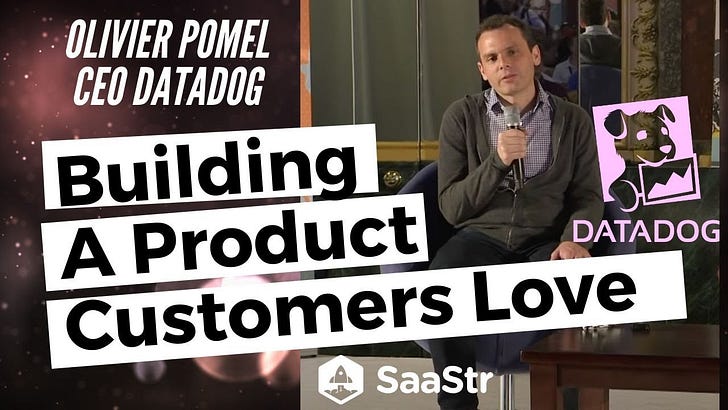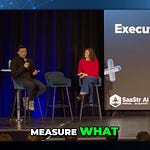Medha Agarwal is a Partner at Defy VC, where she focuses on investments in AI-first and vertical SaaS companies. She shares insights at SaaStr AI Summit 2025 from the front lines of AI-first product pricing, exploring why traditional SaaS models are declining in favor of transactional pricing, how to choose the right pricing structure for your business, and strategies for capturing value from labor budgets instead of software budgets.
Top 5 Takeaways
Transactional pricing is replacing traditional SaaS at an accelerating rate. The fundamental shift is driven by AI’s ability to complete tasks end-to-end, enabling companies to sell into labor budgets rather than software budgets. This opens up significantly larger TAMs that were previously dominated by human labor costs.
There’s a 1.5-2.5x revenue multiple premium for SaaS models in public markets, but transactional models capture more value. While SaaS offers predictability and better cash conversion cycles with annual upfront payments, transactional pricing allows you to scale revenue with customer growth without being constrained by seat count. The trade-off is revenue predictability versus value capture.
Hybrid models are emerging as the best of both worlds. Companies are mitigating transactional pricing unpredictability by implementing tiered subscriptions with usage minimums and overage billing. This provides baseline revenue predictability while maintaining the ability to capture value at scale through consumption-based pricing.
Your pricing model choice depends on four critical factors. Frequency of usage, magnitude of cost savings, workflow integration point, and customer budget type all determine whether fixed-cost, input-based transactional, output-based transactional, or hybrid pricing makes sense. High-frequency tools like Slack need flat fees because users can’t mentally track per-use costs.
Never compete on price alone when entering a market. Undercutting competitors on price creates a dangerous dynamic where you attract price-sensitive customers rather than best-fit customers, leading to higher churn and false signals of product-market fit. Price at par with competitors and win on value, or you’ll be forced into a race to the bottom.
The Fundamental Shift: Why SaaS Pricing Is Dying
We’re witnessing a massive sea change in how AI-first products are priced. At DEFY, we’ve seen a dramatic increase in the frequency of transactional-based pricing models. Traditional SaaS pricing, while still popular, is declining rapidly in favor of transaction-based approaches.
The reason is straightforward. With AI, there’s an increasing ability for software to complete tasks end-to-end. Some AI businesses are enhancing humans and making them significantly more productive than ever before. Others are eliminating the need for humans to perform many entry-level tasks altogether.
This creates a game-changing opportunity. It’s much easier today than it has been in the past to sell into labor budgets, which represent a much larger line item for most companies’ cost structures. Labor is also seen as more mission-critical than software spend. These transactional models can target much larger total addressable markets that were previously captured almost entirely by human labor expenditures, which are now starting to be displaced by software in certain categories.
The Three Pricing Model Archetypes
When we looked at the pricing landscape for AI-first products, we identified three high-level model types that most companies fall into.
Fixed Cost Models: Traditional SaaS
This is your typical traditional SaaS-based, seat-based pricing model. It can be seat-based or location-based pricing. There are compelling reasons why this model has dominated for so long.
If you look at the public markets, SaaS models command a 1.5 to 2.5 times revenue premium multiple compared to transactional-based models. There are several reasons for this valuation gap.
First, it’s extremely predictable for the company selling the software. Second, it’s very predictable for the customer buying it. They can plan for that spend on an annual basis with high confidence. Third, the cash conversion cycle is excellent. These contracts are often paid yearly upfront, which helps fast-growing companies manage their cash flow effectively.
But there are significant trade-offs with fixed pricing models.
As companies grow rapidly, their usage of a product often scales much more quickly than the number of seats they need. This happens because they’re not growing headcount proportionally since the tool is making them much more efficient. The result is that the value a vendor is able to capture is much less than the actual value they’re providing to the company.
Second, there are use cases where you could add enormous value, but the usage isn’t consistent on an everyday basis. This makes SaaS pricing less sensible. Financial planning tools are a perfect example. There will be intense periods of usage, followed by periods of much lighter usage. Paying for a full-time seat year-round doesn’t align with the value delivery pattern.
Transactional Pricing: Input-Based vs. Output-Based
When we think about transactional pricing, it breaks down into two distinct categories: input-based and output-based.
Input-based pricing is when you bill on consumption or usage that ties very closely to traditional API-based usage pricing. You charge for the number of pages processed, the amount of compute consumed, or the number of API calls executed. This model is familiar to developers and technical buyers who understand the cost structure underneath.
Output-based pricing is fundamentally different. It’s much more aligned with how humans work and what they deliver. What is the output? What is the unit of work being completed? If you successfully complete a task, you bill for that unit of work or that task. This is closer to how you’d pay a human contractor or employee for deliverables rather than for effort.
The benefit of transactional-based pricing, whether input-based or output-based, is that you can charge more for each unit of work you’re performing. You can scale revenue much more efficiently with the growth and expanding usage of your existing customers. As they do more, you earn more, without negotiating new contracts or adding seats.
The downside is predictability. You can’t forecast revenue as confidently. There might be a quarter where your revenue is off the charts because customers heavily used your solution. Then another quarter comes where they don’t need to use it as intensively, and revenue drops. This makes it much harder to predict revenue and model your business for investors and your board.
The Hybrid Model: Having Your Cake and Eating It Too
We’ve seen many companies successfully mitigate transactional pricing unpredictability by implementing hybrid models. These combine elements of fixed tiered base subscriptions with usage minimums and consumption-based billing.
Here’s how it typically works. There are three tiers. For tier one, you pay X amount on a monthly or annual basis as a minimum commitment. But that subscription includes X number of credits, either input-based or output-based. If you use more than your included credits, you move into the next tier, and the next tier after that. Companies then back-bill for overage at the end of every quarter based on actual usage.
This structure provides baseline revenue predictability while maintaining the ability to capture value as customer usage scales. It’s becoming increasingly popular among AI-first companies that want to balance investor expectations for predictable revenue with the reality that AI products create value through consumption.
The Evolution: Aligning Price with the Value of Labor
AI-first products, enabled by the evolution of technology, are making pricing models possible that align much more closely with the value of labor rather than the value of software. This is something we’re really excited about at DEFY.
We’ve seen tremendous potential for companies to build very large businesses on top of this ability to target labor spend. The opportunity is massive because labor budgets dwarf software budgets in almost every organization. If you can credibly replace or augment labor with software, you can charge proportionally to the labor cost saved, not just the software value delivered.
How to Choose Your Pricing Model: The Four Critical Factors
It’s extremely important to think through the specific inputs and your unique situation when determining which pricing structure makes the most sense for your business. Every model has trade-offs. Here are the four critical factors you need to evaluate.
Factor 1: Frequency of Usage
How often are customers using your tool? Is it something they use day in and day out, many times per day? If so, usage-based pricing could be really complicated and might gate adoption because users would think twice before using the solution.
Slack is the perfect example. If Slack used usage-based pricing, it would be much harder for you or me to keep track of whether sending a Slack message was worth X cents. We’d mentally calculate the cost before every message, which would create massive friction and reduce usage. That’s a type of product where the frequency of use is so high that customers can’t reasonably predict their costs. A flat fee makes much more sense.
Conversely, if your tool is used infrequently or sporadically, usage-based pricing makes perfect sense. Customers only pay when they get value, and they can clearly see the ROI of each interaction.
Really think carefully about what the impact of pricing either on a fixed basis or usage basis will have on customer adoption and expansion. High-frequency use cases almost always favor fixed pricing to remove mental transaction costs.
Factor 2: Magnitude of Cost Savings
The second factor is understanding how much you’re saving the customer compared to the alternative, which is often human labor. If you’re delivering a 10x cost reduction compared to hiring someone to do the work, you have much more pricing power and can justify premium transactional pricing.
For example, if a customer would need to pay $50 per hour for a human to complete a task, and your AI can do it for $5 worth of usage, that’s a compelling value proposition that justifies transaction-based pricing. You’re directly comparable to labor costs, and the customer can easily calculate their ROI.
But if your cost savings are more marginal, or if the comparison to labor is less direct, you might struggle to justify high transaction prices. In those cases, fixed pricing might make more sense because it’s harder for customers to calculate and justify the per-use ROI.
Factor 3: Integration Point in the Workflow
Where you insert yourself into the customer’s workflow dramatically impacts your pricing model and revenue predictability.
Let’s walk through an example. Imagine you’re building a customer service AI solution. If the customer wants to route all of their incoming support volume through your solution first, and you handle everything you can before escalating to humans, you have massive predictability. You can look at their historical support ticket data and have a pretty good sense of the volume you’ll process. You can plan accordingly, and they have predictability in their costs.
But if they only want to insert you somewhere later in the funnel after a human has already triaged the tickets, and they only route the most complex queries to you, it’s much harder to predict volume. They’re deciding when to bring you into their funnel and what percentage of volume to send your way. Your revenue becomes dependent on their operational decisions, which introduces significant unpredictability.
If you can work with customers consultatively and explain why you should be at the top of the funnel processing all volume, you can help them understand why it’s beneficial to them while also giving yourself more predictable revenue. We have a portfolio company working with logistics companies where they’re the first line of contact when anyone calls. They answer what they can in an automated way, and only route complex issues to humans.
Their argument is compelling. The vast majority of customer needs when they call can be automated. By handling those, you’re reducing call wait times, which leads to lower drop-off and probably reduces lost revenue. Your human team can focus on high-value, complicated tasks instead of spending expensive human time on entry-level support tickets. They charge based on the number of minutes or calls or tickets they resolve, and the customer can predict their costs based on total incoming volume.
Factor 4: Budget Type and Buyer Persona
Understanding whether you’re selling into a software budget or a labor budget fundamentally changes your pricing model and your competitive landscape.
If you’re truly replacing labor, you’re competing against fully loaded employee costs, including salary, benefits, training, management overhead, and retention risk. That’s a much larger budget pool and allows for much higher pricing. You can justify transactional pricing based on tasks completed because you’re directly comparable to what they’d pay a human.
If you’re selling into a software budget, you’re competing against other SaaS tools for limited IT spend. This typically favors fixed, predictable pricing models that IT buyers can budget for annually. The comparison is software versus software, not software versus people.
The buyer persona also matters enormously. A finance or operations leader buying a labor replacement is thinking in very different terms than an IT leader buying software. The finance buyer thinks in terms of cost per unit of work, productivity gains, and headcount planning. The IT buyer thinks in terms of licenses, integrations, and annual contracts.
The Pricing Strategy Question: Never Compete on Price Alone
One of the most important strategic questions early-stage companies face is how to price relative to competitors. Should you charge premium prices, match the market, or undercut competitors to gain initial traction?
I’m not a huge fan of trying to enter a market and take share by underpricing your competitors. That’s a slippery slope for several reasons.
First, if you win on price, competitors can also drop their prices. You haven’t built any sustainable competitive advantage. You’re in a race to the bottom where everyone’s margins compress.
Second, you attract the wrong customers. Are they signing up with you because you’re the cheapest option, or because you’re the best fit for what they need? Price-sensitive customers are often the worst customers. They’ll churn as soon as someone cheaper comes along, or they’ll constantly negotiate for discounts.
Third, it creates false signals of product-market fit. You might see strong initial adoption and think you’ve nailed product-market fit, when in reality you’ve just found a group of bargain hunters. When you try to raise prices or competitors match your pricing, you’ll discover that the demand was price-driven, not value-driven.
That means you might have higher churn down the road, and customers might demand you drop prices further when your competitors inevitably respond. There’s a real risk to scaling your business thinking you have product-market fit when you actually don’t.
I totally agree with founders who want to price at par with existing competitors rather than undercutting them. If you can’t win at comparable prices, you probably don’t have a strong enough value proposition yet. Fix the product and the positioning before trying to fix the problem with pricing discounts.
Determining the Right Model for Your Specific Business
Whether to charge for usage or flat fee or seat-based pricing requires deep customer discovery. You need to understand how customers see your product and the value it delivers.
Do they see it as a labor replacement? If you’re able to do something end-to-end or truly improve the productivity of an individual, you can make a compelling ROI argument for why you should charge a premium price on a usage basis for that work.
Or if they’re using it so much and so frequently that usage tracking becomes burdensome, you need to recognize that. If they’re only going to use your product for the most complicated, edge-case scenarios, then you’re actually limiting your scope and your revenue potential. You might be better off with flat pricing that encourages them to send you more volume, including the easier cases that build your data flywheel and improve your models.
Understanding what your customer is optimizing for is crucial. Are they optimizing for cost predictability? For variable costs that scale with their business? For ROI on specific tasks? The answer should drive your pricing model.
Your First Customers Matter More Than You Think
Being very careful about who your first five to ten customers are is critically important for AI-first products.
You likely have to do significant work, customization, and training to make your product effective for each early customer. If they’re not willing to pay you properly, or you don’t have confidence that customer is going to stick around and provide valuable feedback, it might not be worth the effort to sign them up at all.
Early customers set the precedent for your pricing, your positioning, and your product development roadmap. If you start with customers who are only willing to pay bargain-basement prices, you’ll struggle to raise prices later. If you start with customers who see you as a nice-to-have rather than a must-have, you’ll build features that serve that perception.
Focus on customers who have the problem you solve most acutely, who have budget to pay for solutions, and who will be true partners in developing the product. Don’t optimize for customer count in your first ten or twenty deals. Optimize for customer quality, reference-ability, and learning.
The Bottom Line
Pricing AI-first products is fundamentally different from pricing traditional SaaS because the value proposition is different. When you can complete tasks end-to-end or dramatically amplify human productivity, you’re competing with labor costs, not software costs. That opens up massive TAMs and justifies transactional pricing models that scale with value delivered.
The key is understanding your specific situation across the four critical factors: usage frequency, cost savings magnitude, workflow integration point, and budget type. There’s no one-size-fits-all answer. SaaS pricing still makes sense for high-frequency tools where usage-based billing would create friction. Transactional pricing makes sense when you’re directly replacing human work or processing variable workloads. Hybrid models are emerging as a powerful middle ground that provides predictability while capturing scale.
Whatever you choose, don’t compete on price alone. If you can’t win at market rates, you don’t have product-market fit yet. Fix that first. Your early customers and your early pricing set the trajectory for your entire business. Get them right, and everything else gets easier.
The era of pure SaaS pricing is ending. The companies that figure out how to align their pricing with the labor value they deliver, rather than the software value they provide, will capture the largest TAMs and build the most valuable businesses in the AI era.








